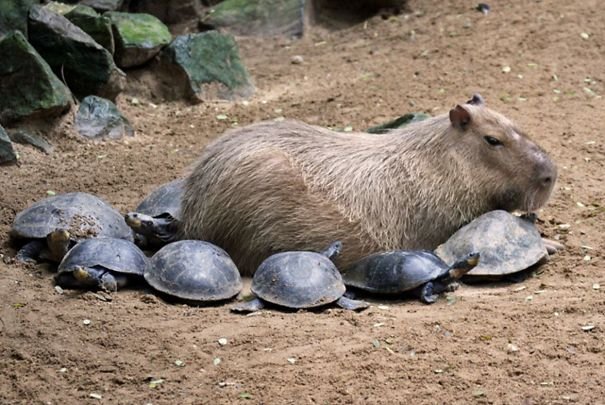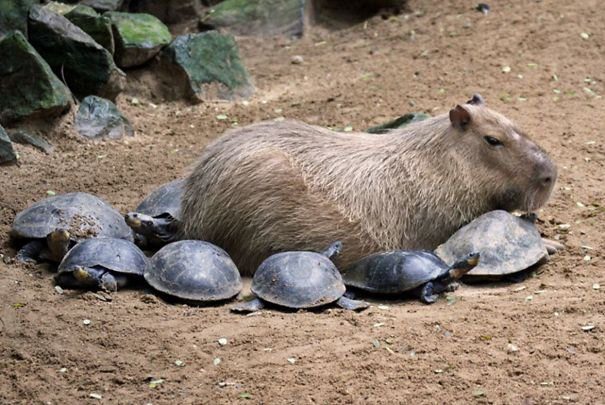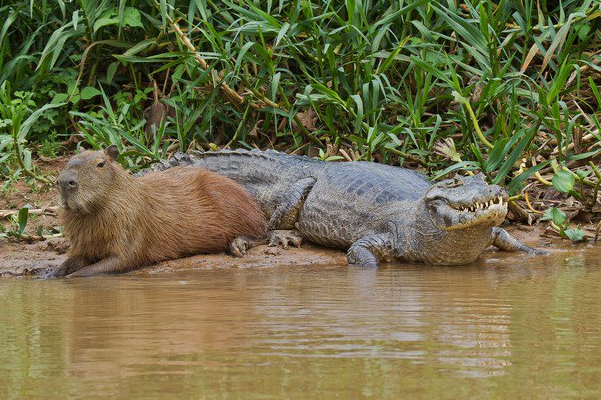Table of Contents
Imagine a world where crocodiles and capybaras peacefully coexist, sharing the same habitat without any conflict. We often perceive these two animals as fierce and territorial, but is it possible for them to have a harmonious relationship? Crocodiles, known for their powerful jaws, and capybaras, the largest rodents in the world, seemingly have different lifestyles and habits. However, recent studies have shed light on intriguing behavior that suggests these creatures may have more in common than we initially thought. Let’s dive into the fascinating realm of crocodiles and capybaras and explore whether they can genuinely coexist in nature.
H2: Physical characteristics of crocodiles and capybaras
Crocodiles and capybaras are two fascinating creatures with distinct physical characteristics. Understanding these features can provide insights into their unique adaptations and functionalities.
H3: Crocodile physical characteristics
Crocodiles are known for their powerful bodies and formidable presence. These reptiles can grow to impressive sizes, with some species reaching lengths of up to 23 feet. Their long, muscular tails play a crucial role in propelling them through the water, allowing them to swiftly navigate their aquatic habitats. Crocodiles possess a barrel-shaped body covered in scaly armor, which acts as a natural defense against potential threats. Additionally, their sharp, interlocking teeth and strong jaws are perfectly designed for capturing and crushing their prey.
H3: Capybara physical characteristics
Unlike crocodiles, capybaras are the largest rodents on Earth. Despite their massive size, they have a relatively gentle appearance. Capybaras typically reach lengths of about four feet and weigh between 77 and 146 pounds. Their bodies are well-suited for life in the water, with short, sturdy legs and partially webbed feet that allow for efficient movement both on land and in water. Capybaras have a barrel-shaped body covered in short, coarse hair, which provides insulation and protection against the elements. Their prominent, slightly protruding eyes enable them to keep a watchful eye on their surroundings, ensuring their safety in the wild.
H2: Natural habitats of crocodiles and capybaras
Understanding the natural habitats of crocodiles and capybaras is essential to comprehend how these animals coexist in the wild.
H3: Crocodile natural habitats
Crocodiles are found in a wide range of habitats, including rivers, lakes, swamps, and estuaries. They are prevalent in both freshwater and saltwater environments, adapting to varying salinity levels. Some species, such as the American crocodile, are found exclusively in coastal areas, while others, like the Nile crocodile, are predominantly found in freshwater habitats. These reptiles require access to water for hunting, mating, and thermoregulation, as well as for shelter during periods of high temperatures or drought.
H3: Capybara natural habitats
Capybaras are native to the tropical and subtropical regions of South America. They are primarily found in wetland areas, such as marshes, swamps, and densely vegetated riverbanks. These herbivorous creatures require access to water for drinking and cooling off, making their proximity to water bodies crucial. Capybaras are agile swimmers and can partially submerge themselves in water to escape from predators or regulate their body temperature. They thrive in habitats with abundant vegetation, providing them with both food and cover.

H2: Diet and feeding habits
The dietary preferences and feeding habits of crocodiles and capybaras greatly influence their coexistence and interactions with one another.
H3: Crocodile diet and feeding habits
Crocodiles are apex predators and are known for their predatory prowess. Depending on their size, species, and available prey, crocodiles can consume a wide variety of animals, including fish, amphibians, reptiles, birds, and mammals. They are primarily ambush hunters, relying on their patience, stealth, and lightning-fast strikes to capture their prey. Crocodiles typically wait patiently near the water’s edge or partially submerged, using their excellent camouflage to blend in seamlessly with their surroundings. Once within striking range, they launch themselves towards their unsuspecting prey, using their powerful jaws to seize and immobilize their target.
H3: Capybara diet and feeding habits
Capybaras have a herbivorous diet, mainly consuming plant material such as grasses, aquatic vegetation, fruits, and bark. They are known as grazers, spending a significant portion of their day feeding on grass and other available vegetation. Capybaras use their sharp incisors to crop grass and their molars to grind down tougher plant matter. These rodents have a unique digestive system that enables them to extract nutrients efficiently from their herbivorous diet. Capybaras often forage in groups, using their social behavior to warn the group of potential threats while grazing.
H2: Interactions in the wild
The dynamic between crocodiles and capybaras in the wild is complex, with both predator-prey dynamics and potential coexistence playing significant roles.
H3: Predation on capybaras by crocodiles
Crocodiles are natural predators of capybaras, especially in areas where their habitats overlap. Capybaras are well aware of this potential threat and have developed behavioral strategies to mitigate the risk. They often remain cautious and alert when near bodies of water, regularly scanning the surroundings for any signs of crocodilian presence. Juvenile capybaras are particularly vulnerable to crocodile predation, and as such, they prefer to stay close to their parents or within social groups for added protection.
H3: Capybara behaviors in the presence of crocodiles
Capybaras display a range of behaviors when encountering crocodiles. They are known to be vigilant and will emit alarm calls to alert other group members of potential danger. Capybaras also utilize their keen sense of smell to detect the scent of crocodiles, allowing them to avoid high-risk areas. When watering or crossing bodies of water, capybaras tend to gather in large groups, which provides safety in numbers. These social gatherings serve as a deterrent for crocodile attacks, making it less likely for an individual capybara to fall prey to these formidable predators.

H2: Coexistence challenges
While crocodiles and capybaras may coexist in some areas, several challenges and conflicts can arise due to competition for resources, territorial conflicts, and the risk of predation.
H3: Competition for resources
Crocodiles and capybaras both rely on water bodies for survival, which can lead to competition for resources such as food, shelter, and breeding sites. In areas with limited resources, this competition can intensify, potentially resulting in negative impacts on one or both species.
H3: Territorial conflicts
Both crocodiles and capybaras exhibit territorial behaviors, defending their preferred areas from intruders. This territoriality can lead to conflicts, as overlapping territories may occur. These conflicts can manifest as aggressive interactions between individuals or groups, as they strive to establish and maintain their territories.
H3: Risk of predation
The risk of predation by crocodiles poses a constant threat to capybaras. In areas where crocodile populations are high, capybaras must navigate their surroundings cautiously to minimize the risk of falling prey to these powerful and stealthy predators. This ongoing pressure of predation can influence the behavior, distribution, and abundance of capybara populations.
H2: Case studies of coexistence
Despite the challenges, there are instances where crocodiles and capybaras successfully share habitats. These case studies provide valuable insights into the mechanisms that enable their coexistence.
H3: Examples of crocodiles and capybaras sharing habitats
In certain regions of South America, crocodiles and capybaras can be found coexisting in wetland areas, such as the Pantanal and the Orinoco basin. These diverse ecosystems offer abundant resources, providing both species with ample opportunities to thrive.
H3: Study findings on their coexistence
Researchers have conducted studies to understand the dynamics of crocodile-capybara coexistence. These studies have revealed that capybaras optimize their behavior to minimize predation risk by actively avoiding areas heavily populated by crocodiles. They strategically select areas with dense vegetation cover and maintain a high level of vigilance in crocodile-prone locations.

H2: Conservation efforts
Conserving the natural habitats of both crocodiles and capybaras is crucial for their survival. Various conservation initiatives and management strategies aim to protect these species and promote their coexistence.
H3: Protected areas and conservation initiatives
Many protected areas around the world have been established to safeguard crocodile and capybara habitats. These areas serve as essential preserves for these species, allowing for the maintenance of their ecological balance and protection against anthropogenic threats.
H3: Management strategies for promoting coexistence
To encourage the coexistence of crocodiles and capybaras, management strategies often focus on habitat preservation and restoration, as well as implementing practices that minimize human impacts on these ecosystems. By ensuring the availability of sufficient resources and minimizing disturbance to their habitats, it becomes more likely for these two species to peacefully coexist.
H2: Human impact on coexistence
Human activities can significantly impact the coexistence of crocodiles and capybaras, exerting both positive and negative effects on their populations and habitats.
H3: Threats to crocodiles and capybaras
Both crocodiles and capybaras face various threats from human activities. Habitat destruction, pollution, hunting, and the illegal wildlife trade pose significant risks to their survival. These threats can disrupt the delicate balance necessary for their coexistence and negatively impact their populations.
H3: Influence of human activities on their coexistence
Human activities can directly or indirectly affect the coexistence of crocodiles and capybaras. For example, land development projects can lead to habitat fragmentation and loss, reducing available resources for both species. However, conservation efforts and awareness campaigns can help mitigate the negative impact of human activities, creating a more harmonious relationship between humans, crocodiles, and capybaras.

H2: Potential future scenarios
As we consider the future of crocodiles and capybaras, it is essential to acknowledge potential scenarios influenced by climate change and the possibility of adaptive behaviors and coevolution.
H3: Climate change and its impact
Climate change poses significant challenges for both crocodiles and capybaras. Rising temperatures, altered rainfall patterns, and habitat loss can disrupt their natural habitats and availability of resources. These changes can have profound effects on their coexistence and ecological dynamics, necessitating adaptive responses to survive in an ever-changing environment.
H3: Adaptive behaviors and potential coevolution
Given the remarkable ability of species to adapt to environmental changes, both crocodiles and capybaras may exhibit adaptive behaviors in response to the challenges posed by climate change. Over time, these behaviors could lead to coevolutionary processes, where both species modify their interactions and traits to enhance their chances of survival.
H2: Conclusion
The coexistence of crocodiles and capybaras is a captivating aspect of the natural world. While challenges and conflicts may arise, these two species have managed to find ways to live alongside each other, adapting to their environments and utilizing various strategies to minimize competition and predation risk. As we continue to study and appreciate the intricacies of their interactions, it becomes increasingly important to protect their habitats and promote conservation efforts that enable their continued coexistence. By doing so, we can contribute to the preservation of these extraordinary creatures and the fragile ecosystems they call home.


